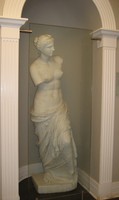The Murphey Hall statues: Bringing great art to campus
Travel at the turn of the twentieth century was an arduous undertaking. The Wright Brothers’ airplane did not leave the ground until 1903, and at that time the fastest crossing of the Atlantic on an ocean vessel took more than five days. Even a road trip from Chapel Hill to Raleigh took hours. Most students on this campus and the vast majority of North Carolinians could therefore only dream of making journeys to explore art galleries in Paris or classical ruins in Greece. Museums in the United States were few, and most were located in the northeast.
There was one way, however, in which famous sculpture could be made accessible to those who could not travel. Plaster reproductions, cast in molds made directly from the original statues, could represent the form of those works with remarkable accuracy. In the late nineteenth century many museums and universities in Europe and North America built collections of such reproductions of classical statuary. Greek gods and goddesses, especially figures of Aphrodite, Apollo, and Athena, were the most popular subjects acquired.
Aphrodite of Melos
To the Greeks, the goddess Aphrodite represented love and beauty; the god Apollo, music and healing; and the goddess Athena, wisdom and war. As class gifts to the University, these casts brought a bit of antiquity to Chapel Hill and provided the campus community with models of fine art to study and admire.

A French naval officer discovered the original sculpture on the Aegean island of Melos in 1820. Purchased immediately by the French ambassador, the statue was shipped to Paris, where it was presented to King Louis XVIII and deposited in the Louvre. More commonly known as the “Venus de Milo,” this work has remained one of the most famous statues in the world.
APOLLO

The original sculpture was uncovered near Rome around 1500 and displayed in the Vatican Palace’s Belvedere Courtyard. Once thought to be a Greek sculpture, the statue — nicknamed “Apollo Belvedere” — is more likely a Roman copy of an earlier Greek bronze. The original sculpture is a nude, but turn-of-the-century mores prompted the maker of this copy to cover Apollo’s genitals with a fig leaf. Also, while the original statue has arms and a cape, this reproduction has been damaged over the years during moves to various locations on campus, resulting in the loss of these distinctive features.
ATHENA

Today, the original statue is part of the Vatican’s collection in Rome. Owned earlier by the prominent Giustiniani family, the work is also known as “Minerva Giustiniani.”